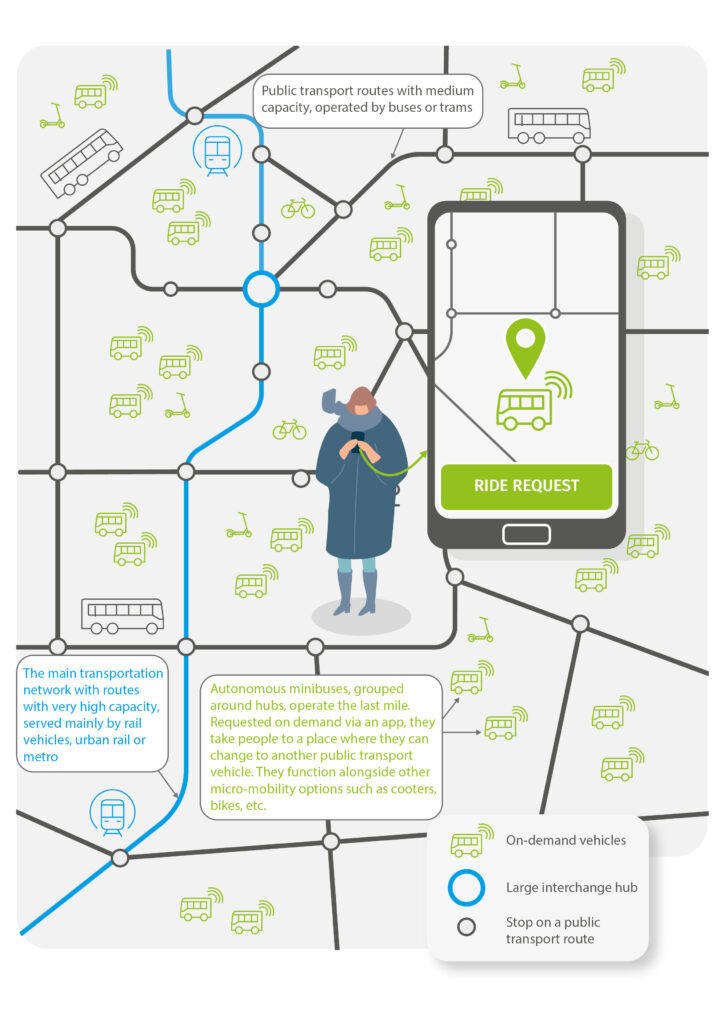UITP: 140 years of mobility and one question that remains as relevant as ever
Before the Summit in Hamburg begins, it is worth taking a closer look at what UITP is.

Demand-responsive transport – the latest trends in urban transport
Not only a bus stop, but a whole ride, on demand – does that make sense? Definitely! One just needs to change existing modes of thinking, to exploit the potential of information technologies and the existing communication infrastructure. New trends in operating public transport networks provide answers to old challenges.
How to encourage residents to use public transport? It has been, for years, one of the main challenges faced by city authorities. Despite growing environmental awareness and the saturation of cities with cars, people often still opt to travel in their own car rather than take a bus or tram. The latest trends in organising public transport systems show a very interesting solution to this problem.

Is the traditional public transport model sufficient today?
The previous approach assumed a rigid system to which residents were expected to adapt. Cities are criss-crossed by public transport routes, which are set out top-down. On these lines on these lines, public transport vehicles follow a fixed timetable. It is the passenger’s role to get to a specific place at a specific time in order to use the transport service.
While transparency and predictability are undoubtedly an advantage of this system, the problem lies in the above-mentioned rigidity and lack of flexibility. A city is a living organism, subject to constant changes, and a transport network, once established, does not always keep up with the needs of passengers.
Operators are very familiar with the problem of empty buses, where too few passengers ride on a given bus route, which naturally generates high costs. On the other hand, giving up on such a bus route would exclude people who use it regularly.
Last mile
Another challenge is the problem of the first and last mile. Residents become discouraged by the distance to the nearest bus stop or an interchange hub, which makes the journey last much longer. This problem greatly affects older people and people with disabilities, who are simply not able to walk the distance to or from the bus stop by themselves. In such cases, it is much easier and quicker to use a car or a taxi, even taking into account annoying traffic jams or higher travelling costs.
Response: Demand-Responsive Transport (DRT)
Demand-Responsive Transport (DRT) addresses today’s challenges. This idea of transportation implies a completely new way of perceiving the public transport network and the role of a passenger. The needs of the passenger come first here. The main idea behind this transport system is to enable passengers to reach large transport hubs in a convenient way. How? Well, by using a system of minibuses which run deep into residential districts or remote suburban areas.
Small minibuses pick people up and take them to the next destination where they can change to another public transport vehicle: bus, tram, metro or suburban rail. Smart buses run solely when demanded by passengers who can summon the service by telephone or with a dedicated mobile phone app. Thus, passengers get around the city quicker and more comfortably, and the operator doesn’t have to operate bus routes with low passenger demand.
In this way, the public transport network is changing its character from a linear to a hub system, encompassing many mini hubs that are reached by passengers. Importantly, this change in the public transport system doesn’t involve changes in the existing infrastructure. It is only about the complementary services and exploiting this infrastructure to the maximum extent.

@Big data
Use and analysis of digital data is a very important element determining the success and efficiency of DRT-based transport. The appropriate integration of data and the update are the basis not only for planning the routes operated by smart buses, but also for developing mobile applications for passengers that enable them to request a lift in a convenient way.
By using application on their smartphone, passengers can, among other things, check if there is a bus nearby that is going to their desired destination and, via an online request, request it to stop at the desired location. This makes it much easier to plan a journey from A to B, and the passenger is not discouraged from using public transport by waiting a long time at the bus stop. Operators, in turn, monitor in real time how the needs of residents are developing and see whether the services they offer are efficient.
Buses deployed to provide such transport services generate lower costs than maintaining regular routes served by larger vehicles. Their efficiency is also increased as they are dispatched only to destinations where they are currently needed.
Owl or squirrel?
Public transport on demand is not only an interesting idea for the future, but is actually an increasingly widespread solution currently being tested and deployed in numerous towns and cities across the world, for example, in Seoul, Singapore, Sydney, Frankfurt, Szczecin and Cracow, and in the region of Ile de France, and around Wales.
Particularly noteworthy is the case of Seoul, where smart buses set off at night (Owl Buses) or periodically during the rush hour, providing transport services for passengers on the most congested, short routes (Squirrel Buses). The operator provides a sufficient number of buses on a given route on the basis of big data analysis. At night, active mobile devices in a given neighbourhood are monitored, as well as the number of taxis being ordered. During the day, on the other hand, the buses are made available based on traffic intensity data.
This demand-responsive public transport solution is also rapidly developing in the French region of Il de France. Smart buses are already available in 21 designated zones around Paris, and residents can request a ride every weekday, either by phone or via a dedicated app.

This demand-responsive public transport solution is also rapidly developing in the French region of Il de France. Smart buses are already available in 21 designated zones around Paris, and residents can request a ride every weekday, either by phone or via a dedicated app.
Is DRT a future?
Will the idea of DRT services become part and parcel of the landscape of modern metropolises? Well, we will see for ourselves in the coming years, but one thing is certain – in our fight against pollution and congested streets, it is worth taking up the challenge.
Before the Summit in Hamburg begins, it is worth taking a closer look at what UITP is.
Learn more about the changes introduced by GSR2 and how they contribute to protecting all road users.
BRT in Aalborg: the city's solution for enhancing urban transport – what makes it so effective?